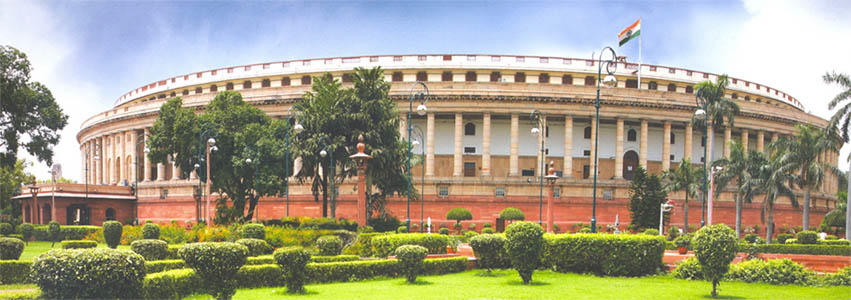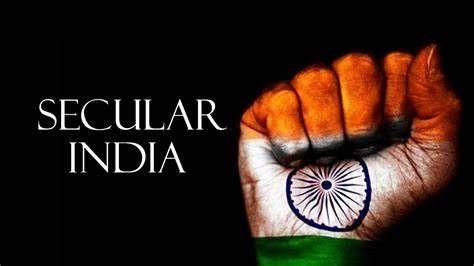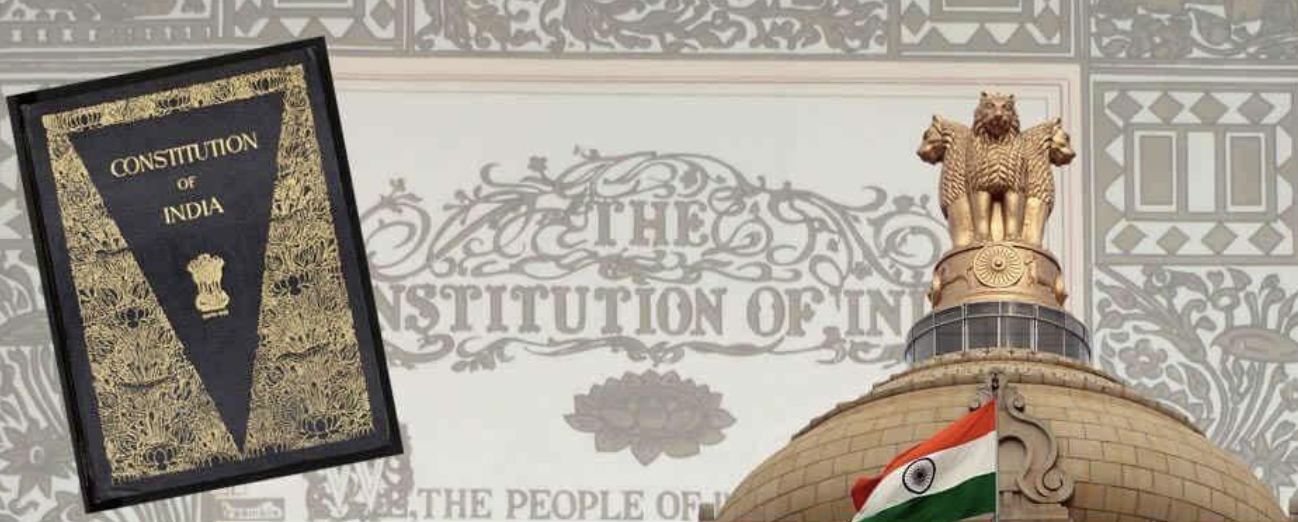A constitution is the rule book for a state. It sets out the fundamental principles by which the state is governed. It describes the main institutions of the State and defines the relationship between these institutions (for example, between the executive, legislature, and judiciary). It limits the exercise of power and sets out the rights and duties of citizens. Constitutions may be written or unwritten, codified or uncodified, and complex or simple, providing vastly different governance patterns.
The Constitution of India came into force on 26th January 1950. At the time of its adoption, the Constitution contained 395 Articles and 8 Schedules and was about 145,000 words long, making it the longest national Constitution ever to be adopted. Every Article in the Constitution was debated by the members of the Constituent Assembly, who sat for 11 sessions and 167 days to frame the Constitution, over 2 years and 11 months.
November 26 is celebrated as Constitution Day. Find out more about the constitution of India why we must honor and celebrate our Constitution and how we can do so on this auspicious day.

The Preamble to the Constitution
The preamble is an introductory statement in the Constitution that explains the reasons and guiding values of the Constitution. The Preamble is the soul of the Indian Constitution, which contains the philosophy on which the Constitution was built.

The Constituent Assembly debated the Preamble on 17th October 1949. The debates around the Preamble revolved around the name of India and the inclusion of 'God' and 'Gandhi.' One member urged the Assembly to rename India as the ‘Union of Indian Socialistic Republics’, similar to the USSR. This suggestion did not convince members as they felt it would go against the already adopted constitutional scheme.
Another member sought to include ‘In the name of God. Many were opposed to this suggestion – it was noted that it was unfortunate to put ‘God’ on the vote. One member believed that the inclusion of ‘God’ would amount to a ‘compulsion of faith’ and violate the fundamental right to freedom of faith.
Another proposal was made to include Gandhi’s name in the Preamble. A member was discontent with the already adopted draft articles as he felt that the Indian constitution was based on the American Supreme Court cases and the Government of India Act. He opposed any association of Gandhi with the ‘rotten Constitution.’
The amendments moved by the members were negative. However, this was one of the rare instances of the Assembly proceedings wherein the members voted on the proposal to include ‘God’ by a show of hands. The Assembly was divided, with 41 voting in favor and 68 voting against it.
The Indian Preamble holds some distinct features that set it apart:
- Sovereign: Signifies India's complete independence and autonomy from external control or interference. It denotes that India has the authority to govern itself without external influence.
- Socialist: Reflects the commitment to a socialist society aiming for equitable distribution of resources and opportunities, social justice, and welfare of all citizens.The term "socialist" was added to the Preamble by the 42nd Constitutional Amendment in 1976
- Secular: Underlines the principle of religious neutrality by the state, ensuring equal treatment of all religions without favoring any particular faith. It guarantees religious freedom to all citizens.
- Democratic: Emphasizes the democratic structure of governance where the power rests with the people, ensuring representation, participation, and accountability through elected representatives.
- Republic: This signifies a form of government where the head of state is elected and not a hereditary monarch. It underscores the principles of a representative democracy. India being a republic, where the head of state is elected and not a hereditary monarch, draws inspiration from republican forms of government prevalent in various ancient and modern societies. It signifies a government based on the consent of the governed and the rule of law.
These adjectives in the Preamble encapsulate the foundational principles and values upon which the Indian state and its governance are built.
Must Know These Features Of The Indian Constitution
Longest Written Constitution
The Constitution of India is the lengthiest and most detailed constitutional document the world has produced. It is a very comprehensive, elaborate, and detailed document. The factors responsible for this are:
- The vastness of the country and its diversity.
- The influences of history, such as the Government of India Act of 1935
- Single constitution for both the Centre and the states
- The dominance of legal luminaries in the Constituent Assembly
The original length when it was enacted in 1949 was around 395 articles and 8 schedules. It is the second longest active constitution in the world with around 145,000 words.
Drawn from Various Sources
The Constitution of India has borrowed most of its provisions from the constitutions of various other countries and the Government of India Act of 1935. Dr. B R Ambedkar proudly acclaimed that the Constitution of India has been framed after ‘ransacking all the known Constitutions of the world.'
The structural part of the Constitution is, to a large extent, derived from the Government of India Act of 1935. The philosophical part of the Constitution (Fundamental Rights and the Directive Principles of State Policy) derives their inspiration from the American and Irish Constitutions, respectively. The political part of the Constitution (the principle of Cabinet government and the relations between the executive and the legislature) has been largely drawn from the British Constitution.
The Indian Constitution draws its principles from various sources:
- British Constitution: India inherited some elements from the British Constitution, like parliamentary government, rule of law, and legislative procedures.
- Government of India Act, 1935: Many features of the Indian Constitution, such as the federal scheme, office of governor, judiciary, and public service commissions, were inspired by this act.
- US Constitution: Concepts like fundamental rights, the Supreme Court, and the idea of a federal structure draw influence from the American Constitution.
- Irish Constitution: Directive Principles of State Policy were inspired by the Irish Constitution.
- Soviet Constitution: Principles of justice, liberty, equality, and fraternity were influenced by the Soviet Constitution.
- French Constitution: Concepts of liberty, equality, and fraternity also found their roots in the French Revolution and its subsequent constitutional developments.
- Australian Constitution: The concept of a concurrent list and joint sitting of the two houses of Parliament were adapted from the Australian Constitution.
- Canadian Constitution: The idea of a federation and the appointment of state governors find some inspiration from the Canadian Constitution.
The Indian Constitution amalgamates these influences, customizing them to suit the unique needs and aspirations of its diverse population.
Blend of Rigidity and Flexibility
The Indian Constitution is a unique example of the combination of rigidity and flexibility. A constitution may be called rigid or flexible based on its amending procedure. The Indian Constitution provides for three types of amendments ranging from simple to most difficult procedures depending on the nature of the amendment.
Federal System with Unitary Bias
The Constitution of India establishes a federal system of government. It contains all the usual features of a federation, such as two governments, division of powers, written constitution, the supremacy of the constitution, rigidity of the Constitution, independent judiciary, and bicameralism.
However, the Indian Constitution also contains many unitary or non-federal features, such as a strong Centre, a single Constitution, the appointment of a state governor by the Centre, all-India services, an integrated judiciary, and so on.

Moreover, the term ‘Federation’ has nowhere been used in the Constitution. Article 1 describes India as a ‘Union of States,' which implies two things:
- Indian Federation is not the result of an agreement by the states.
- No state has the right to secede from the federation.
Parliamentary Form of Government
The Constitution of India has opted for the British Parliamentary System of Government rather than the American Presidential system of government. The parliamentary system is based on the principle of cooperation and coordination between the legislative and executive organs. In contrast, the presidential system is based on the doctrine of separation of powers between the two organs.
Synthesis of Parliamentary Sovereignty and Judicial Supremacy
The doctrine of the sovereignty of Parliament is associated with the British Parliament, while the principle of judicial supremacy is with that of the American Supreme Court. The framers of the Indian Constitution have preferred a proper synthesis between the British principle of parliamentary sovereignty and the American principle of Judicial supremacy. The Supreme Court can declare parliamentary laws unconstitutional through its power of judicial review. The Parliament can amend the major portion of the Constitution through its constituent power.
Rule Of Law
According to this axiom, people are ruled by law but not by men, that is, the basic truism that no man is infallible. The axiom is vital to a democracy. More important is the meaning that law is the sovereign in democracy.
The chief ingredient of law is custom, which is the habitual practices and beliefs of common people over a long number of years.
In the final analysis, rule of law means the sovereignty of the common man’s collective wisdom. Apart from this crucial meaning, rule of law means a few more things like:
- There is no room for arbitrariness
- Each individual enjoys some fundamental rights, and
- The highest judiciary is the final authority in maintaining the sanctity of the law of the land.
Fundamental Rights
Part III of the Indian Constitution guarantees 6 fundamental rights to all Indian citizens. Fundamental Rights are one of the important features of the Indian Constitution. The Constitution contains the basic principle that every individual is entitled to enjoy certain rights as a human being, and such rights do not depend upon the will of any majority or minority.
No majority has the right to abrogate such rights. The fundamental rights are meant to promote the idea of political democracy. They operate as limitations on executive tyranny and the legislature's arbitrary laws. They are justiciable and enforceable by the courts for their violation.
Directive Principles of State Policy
According to Dr. B R Ambedkar, the Directive Principles of State Policy is a ‘novel feature’ of the Indian Constitution. They are enumerated in Part IV of the Constitution. The Directive Principles were included in our Constitution to provide social and economic justice to our people. Directive Principles aim at establishing a welfare state in India where there will be no concentration of wealth in the hands of a few. They are non-justiciable.
Fundamental Duties
The original constitution did not provide for the fundamental duties of the citizens. They were added to our Constitution by the 42nd Amendment Act of 1976 on the recommendation of the Swaran Singh Committee. It lays down a list of 10 Fundamental Duties for all citizens of India. Later, the 86th Constitutional Amendment Act of 2002 added 1 more fundamental duty. While the rights are guaranteed to the people, the duties are obligations that every citizen is expected to perform. However, like the Directive Principles of State Policy, the duties are also non-justiciable.

Indian Secularism
The Constitution of India stands for a secular state. Hence, it does not uphold any particular religion as the official religion of the Indian State. The distinguishing features of a secular democracy contemplated by the Constitution of India are:
- The State will not identify itself with or be controlled by any religion;
- While the State guarantees everyone the right to profess whatever religion one chooses to follow (which also includes the right to be an antagonist or an atheist), it will not accord preferential treatment to any of them;
- The State will show no discrimination against any person on account of his religion or faith
- The right of every citizen, subject to any general condition, to enter any office under the state will be equal to that of fellow citizens. Political equality, which entitles any Indian citizen to seek the highest office under the State, is the heart and soul of secularism as envisaged by the Constitution.
The Constitution abolished the old system of communal representation. However, it provides for the temporary reservation of seats for the scheduled castes and scheduled tribes to ensure adequate representation of them.
The Constitution wasn't printed or typed out — calligrapher Prem Behari Narain Raizada handwrote it in a flowing italics style. Raizada, who belongs to a family of calligraphers, was asked by Jawaharlal Nehru to write the first copy of the document. Each page of the handwritten document was decorated by artists like Beohar Rammanohar Sinha and Nandalal Bose from Shantiniketan, West Bengal.
UPSC Questions On Features Of the Indian Constitution
Question: Explain the salient features of the Constitution (One Hundred and First Amendment) Act, 2016. Do you think it is efficacious enough to remove the cascading effect of taxes and provide for the common national market for goods and services? (250 words)
Answer: The Constitution (One Hundred and First Amendment) Act, 2016, introduced the Goods and Services Tax (GST) in India, marking a significant shift in the country's tax structure. Here are some salient features:
- Unified Tax System: GST replaced multiple indirect taxes levied by the state and central governments with a single, comprehensive tax, streamlining the taxation process.
- Dual GST Model: It follows a dual system comprising Central GST (CGST) levied by the central government and State GST (SGST) by the respective state governments, ensuring fiscal autonomy for both.
- Elimination of Cascading Effect: GST aims to eliminate the cascading effect of taxes by allowing businesses to claim credit for taxes paid on inputs, thus reducing the tax burden on the final consumer.
- Threshold Exemptions: Small businesses enjoy threshold exemptions, reducing compliance burdens for entities below a certain turnover threshold.
- Creation of a Common National Market: By harmonizing tax rates and procedures across states, GST facilitates the creation of a unified national market for goods and services, promoting ease of trade and commerce.
- Online Portal: A robust online portal, the GST Network (GSTN), was established to facilitate registration, filing, and payment of taxes, making the process more transparent and efficient.
- Constitutional Amendment: The Act amended various articles in the Constitution to empower both the central and state governments to levy and collect GST.
Question: Discuss each adjective attached to the word ‘Republic’ in the ‘Preamble’. Are they defendable in the present circumstances?
Answer: The Preamble of the Indian Constitution describes India as a "Sovereign Socialist Secular Democratic Republic." Let's break down each adjective and discuss its relevance in present circumstances:
- Sovereign: This term signifies India's complete independence and autonomy from any external interference. In present times, India maintains its sovereignty by participating actively in global affairs, forming alliances, and engaging in diplomatic relations while safeguarding its interests. However, challenges like geopolitical dynamics and economic interdependence may test this sovereignty.
- Socialist: This term was added by the 42nd Amendment in 1976, aiming for a more equitable distribution of resources and opportunities. India's economic policies have evolved, incorporating elements of socialism while embracing a mixed economy. Presently, while India has moved towards liberalization and privatization, social welfare schemes and public-sector enterprises continue to reflect socialist ideals, albeit in a modified form.
- Secular: India's secularism entails equal treatment of all religions by the state. It assures religious freedom and prevents the state from favoring any particular religion. In contemporary times, India faces challenges regarding communal tensions, debates on religious rights, and incidents that test the secular fabric. The interpretation and application of secularism remain topics of ongoing debate and contention.
- Democratic: India's democratic setup involves a government elected by the people, ensuring participation, representation, and accountability. India boasts a robust democratic structure with regular elections at various levels. However, issues like political polarization, electoral reforms, and the effectiveness of democratic institutions continue to be debated.
- Republic: A republic signifies a system where the head of the state is not a hereditary monarch but elected by the people or their representatives. India's republican structure with elected representatives at various levels has sustained over decades. The presidency, both at the national and state levels, operates on democratic principles of election rather than inheritance.
In the present circumstances, each adjective in the Preamble remains defendable but subject to interpretation and contextual relevance.











